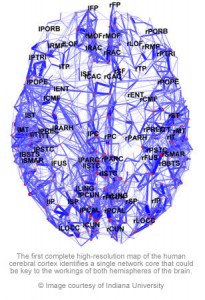 Through the power of Google Earth, you can travel the globe from the comfort of your computer screen, peering down on everything from above. But once you change your perspective – if you go into one of the buildings that you’ve looked down on – you have to upload a new map. Now, researchers at the Norwegian University of Science and Technology (NTNU) have discovered that the brain also creates multiple independent maps while finding the way in the physical world.
Through the power of Google Earth, you can travel the globe from the comfort of your computer screen, peering down on everything from above. But once you change your perspective – if you go into one of the buildings that you’ve looked down on – you have to upload a new map. Now, researchers at the Norwegian University of Science and Technology (NTNU) have discovered that the brain also creates multiple independent maps while finding the way in the physical world.
Four years ago, researchers at NTNU’s Kavli Institute for Systems Neuroscience were the first to discover the intricacies of how the brain creates internal maps using so-called grid cells in a coordinate system. Now postdoc Dori Derdikman and his colleagues from the same research team have uncovered a whole new aspect of how the brain’s mapping system works. Instead of just one big map, the brain makes a whole series of maps, some very fine grained, and some more rough – along with an advanced sorting system.
One map or many?
“We long wondered if all of the brain’s mapping information was stored in a single map” Derdikman says. “So we figured out a way to check this.”
In a new study, published in Nature Neuroscience, the researchers measured the brain activity of laboratory rats allowed to roam freely in a small compartment. The measurements created a map that corresponded to how the rat’s grid cells mapped out the area. Once the researchers had a clear understanding of what the rat’s mental map looked like, they changed the layout of the compartment. Instead of an open area, the rats were now confronted with a labyrinth of long, narrow corridors in a hairpin maze — created by the insertion of walls in the compartment.
“When the walls were inserted, something happened with the rats’ maps” Derdikman explained. “First we recorded the same map. But when the rats came around a hairpin turn in the maze, the map changed totally. It happened several times, each time in connection with when the rats went around a wall and came into a new corridor.” If the rat had been using the same map that it had created for the open compartment, the map would have remained unchanged, he said.
Confusion or geography
Derdikman also checked to see if it was confusing for the rats to change direction all the time because of the maze walls, and whether that could be the reason why the maps were restarted for each new corridor. Rats were trained to run the same route formed by the hairpin maze, but in a compartment without partitions. In this case, the rat used the same map as when it ran freely in the open compartment. That means that it is the physical environment that triggers the creation of a new map, not the rat’s learned behaviour.
Border cells are key
How is it that so many different maps are linked to the surrounding walls?
A recently discovered cell type, border cells, which are active along certain walls in a given environment, may shed light on this question. Border cells describe the limits of how an environmental ends and another begins.
“Maybe these border cells are what signal the brain that to switch maps when you move over a border in your environment”, says Derdikman’s colleague at the Kavli Institute, Trygve Solstad, who was lead author of a 2008 article in Science magazine that reported the presence of the cells. “We think that there is this kind of environmental change when the rat enters a new corridor in the hairpin maze.”
But the definitive answer to the question will have to wait until a research project examines how border cells behave in a fragmented environment.
Rat brains and human brains
The rat brain mapping system thus consists of a series of small maps, not just a single large one. The brain uses its mapping mechanisms to stitch all these maps together. The researchers say that these findings in rats are likely true in the human brain. The part of the brain that contains our sense of place, the entorhinal cortex, is among the oldest and best conserved areas of the brain across evolution, and thus is very similar in humans and animals.
A systematic series of maps
In another study at Kavli Institute for Systems Neuroscience, published in Science, Kirsten Kjelstrup and colleagues found that the mental maps are constructed in a systematic way. “We need maps of varying resolution, some small detailed maps, and other, larger rougher maps”, Solstad says. “And the brain sorts these very systematically.”
The maps are stored as extremely thin cards in a deck in the hippocampus, the area that is regarded as the brain’s memory focal point. The deck is sorted by rank, so that the fine-grained detail maps located at the top, with the biggest, most coarsely drawn maps the further down in the deck that you come.
Source:The Norwegian University of Science and Technology (NTNU)

